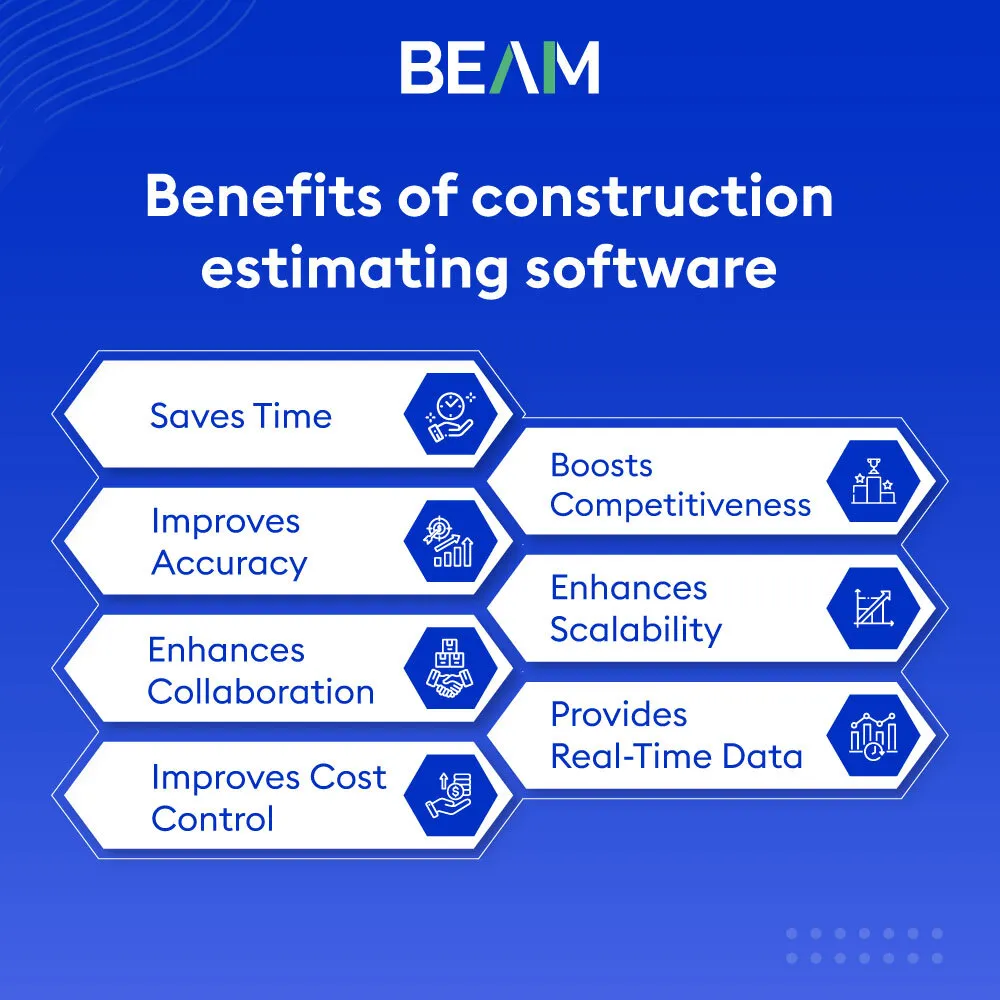Let us paint a picture for you:
Your construction company lands on a huge contract. You check, and the numbers seem solid, so you start working.
What once was your ‘winning’ project feels like a financial nightmare you can’t wake up from.
Soon after, the material costs spike, labor expenses run higher than estimated, and delays start eating into your profits.
The question is: What went wrong?
Nope, it’s not bad luck. It’s poor forecasting. And it’s costing the construction industry pretty pennies in the form of cost overruns.
This is why you need construction forecasting software.
It will help you stay one step ahead, control costs, and make 2025 the last year you lose money due to poor forecasting.
Read this blog to learn everything you need to know about construction forecasting software, along with our top 3 picks.

[Source]
Construction Forecasting Software
Construction forecasting software is a smart digital solution designed to help construction firms predict project outcomes.
It analyzes previous data, tracks current performance, and assesses future trends to tell you if a project is worth the risk.
While it’s not something a human can’t do, using software certainly diminishes the chances of errors.
You’ll receive a clear, data-driven approach to managing your schedule, resources, and costs.
Beyond this, these budgeting and forecasting tools are also great at budgeting, scheduling, and managing your overall project.
Why Accurate Forecasting is Crucial in 2025
Everyone presumes a constructor’s job is to build.
While they are not wrong, there’s a lot going on behind the scenes that makes a construction firm successful.
One of these things is accurate forecasting. A lesser-known fact is that inaccurate forecasting and inadequate data management are among the leading causes of loss in the construction industry.
In fact, according to a study done by FMI Corporation in September 2021, the construction industry may have lost around $1.8 trillion due to poor forecasting and data strategies.
It’s 2025, and these figures will surely rise if we do not take active measures right now. Here is why accurate forecasting in construction budget management is incredibly important:
1. Lesser Impact of Rising Costs
Accurate cost estimates are a part of good financial planning.
Setting up a project budget and timeline isn’t as challenging if you have improved cost forecasting with job-focused software.
Construction forecasting involves considering many factors, including past costs, market trends, and ever-changing material and labor prices. Whew! It’s a lot to juggle.
But with budgeting and forecasting software, you can focus on getting things done while it analyzes situations and data to predict cost changes.
2. Ensures On Time Project Completion
Delays are frowned upon everywhere, but in the construction industry, every extra day costs money.
Construction budgeting software tells you exactly how much money you need to execute the project successfully.
3. Better Customer Experience
Accurate forecasting and customer satisfaction go hand in hand.
Ask yourself: would you rather work with someone who keeps asking for more money every few weeks or someone who sticks to their original price and timeline? I think we all know the answer!
Human calculations aren’t always reliable (unless you’ve hired a math genius!).
But project budgeting software is a completely different story. It’s fast, precise, and helps prevent costly miscalculations.
When you complete projects on time and within budget, your customers stay happy. They trust you to deliver as promised, and happy customers are more likely to recommend your services to others.
All things considered, implementing construction forecasting software feels like a win-win.
It helps cut down on costly risks and keeps your profits steady.
Plus, when has technology ever let us down? (Okay, let’s just go with it!)

[Source]
Key Features of Construction Forecasting Software
Construction forecasting software comes with all sorts of features – some useful, some you might never use. Here are the key features that really matter.
1. Budget & Cost Forecasting
The software you choose must be able to predict future expenses by simply analyzing previous and real-time data.
Also, a cost-tracking feature should be there to monitor project costs closely to ensure you don’t spend more than your budget.
2. Forecasting Timelines & Schedules
An efficient software analyzes data and gives you an expected project completion date.
It can even spot potential delays before they arise so you can adjust your plans and schedules accordingly.
3. Resource Optimization Tools
With so much happening on a construction project, it’s tough to know if your resources are being used in the best way possible.
The right project forecasting software doesn’t just crunch numbers and predict costs.
Instead, it actually helps you make smarter decisions about how to use your resources efficiently.
4. Integration with Tools & Real-Time Data
If you’re already using separate tools, like project budget software, adding another tool to the mix can feel confusing.
A great forecasting tool should easily connect with your accounting, scheduling, and project management systems.
Top Construction Forecasting Software for 2025
Switching to new technology can feel intimidating, but once you take the leap, you’ll wonder how you ever managed without it!
If you’re using construction forecasting software for the first time, the number of options out there might feel overwhelming.
Based on our experience, here are the top three tools worth a shot.
1. Procore
Procore is a cloud-based construction management software that makes projects smoother from the beginning.
It brings the owners, general contractors, and specialty contractors onto one connected platform for enhanced teamwork and efficiency.
Key Features:
- Digital Time Card
- Advanced Scheduling
- Document Management
- Task & Site Management
- Over 100 Pre-Built Reports
- Integration with 500+ Apps
Pros:
- Easy-to-use interface
- Strong document management system
- Excellent project tracking features
- Great customer support
- Works well with many other apps
- Customizable views and filters
Cons:
- Limited offline access
- Can be tricky to set up integrations
- May feel overwhelming for smaller projects
Oracle Primavera P6
Oracle Primavera P6 has become a go-to choice for construction professionals as it offers a range of specialized features designed to handle the unique challenges of the industry.
Key Features:
- Project Planning and Scheduling
- Resource Management
- Cost Control
- Risk Management
- Reporting and Analytics
Pros:
- Highly flexible task management
- Can be used on more than one device
- Integrable with Oracle and other third-party tools
- Allows multiple people to work on the same project simultaneously
- Real-time reporting
Cons:
- Expensive for small to medium-scale construction companies
- Steep learning curve
- Complicated interface
Buildertrend
Buildertrend brings everything that you need on one platform.
Project forecasting? Check. Scheduling? Check. Client communication? Double check!
Key Features:
- Client Portal
- Project Scheduling
- Daily Logs
- Lead Management
- Budgeting and Financial Management
- Warranty Management
- Bid Management
Pros:
- Highly compatible with construction projects
- Easy-to-use
- Default payment processing
- Client portal
- Budget tool
Cons:
- Expensive
- Doesn’t come with a free trial
- Getting started can be complicated
Here’s a quick comparison of these three platforms:
| Feature | Procore | Oracle Primavera P6 | Buildertrend |
| Pricing | Starts at $375 per month | Pricing starts at $2,570, excluding maintenance costs | Starts at $499 per month |
| Key Features | Digital Time CardAdvanced SchedulingDocument ManagementTask & Site ManagementOver 100 Pre-Built ReportsIntegration with 500+ Apps | Project Planning and SchedulingResource ManagementCost ControlRisk ManagementReporting and Analytics | Client PortalProject SchedulingDaily LogsLead ManagementBudgeting and Financial ManagementWarranty ManagementBid Management |
| Ideal Users | Suitable for medium to large construction companies | Best suited for large-scale construction projects | Ideal for small to medium-sized construction firms |
How to Choose the Right Software for Your Business
Every project is unique because it comes with its own set of needs, challenges, and goals.
The same goes for construction companies. Just because a certain software works well for someone else’s business doesn’t mean it’ll be the right fit for yours.
Here’s what to do to ensure you pick the best construction forecasting software for your business.

[Source]
Step 1: Determine Your Needs
Figure out exactly why you want to invest in construction forecasting software. Is it for estimating costs? Budgeting? Allocating resources?
Knowing ‘why’ you need can help point you out in the right direction for ‘what’ you need.
Step 2: Set Your Budget
Narrow down your options by defining a budget for your investment.
Remember, it’s not just the upfront cost that matters. You’ll also have to pay for its ongoing costs like maintenance and updates.
Step 3: Assess Usability
If the software is too complicated, getting your team on board and training them on how to use it properly will be a nightmare.
Good construction forecasting software should be intuitive, have a not-so-steep learning curve, and must be user-friendly.
Step 4: Check the Integration Capabilities
Your construction forecast software should be able to integrate with your existing systems seamlessly.
Otherwise, it will be more of a hassle than help.
Step 5: Test the System
As the saying goes, don’t buy the whole cow before tasting the milk.
Most service providers offer free demos and trials, so you can try before you buy.
Avail this opportunity to explore the software’s features before you pay for it. Does it have everything you need? Will it be a good long-term investment in your firm’s future?
Apart from this, factoring in the following will allow you to make a fully informed decision:
- Scalability: Even if you might be an SME right now, you’ll eventually grow. When you do, you’ll need software that can grow with you.
- Customization: Every company has its unique workflows and processes. You should be able to customize your system to ensure a seamless transition.
- Cloud-Based vs. On-Premises: Cloud-based solutions for construction companies allow access to the software anytime, anywhere, while an on-premises system does not. Determine what’s best for you!
- Security: Since you’ll be entering sensitive project details and financial data into the software, you need one you can trust. Choose wisely!
Most companies prioritize cost over functionality. That’s a mistake you don’t want to make.
You must strike a balance between both to ensure successful implementation.
Not having a clear idea of your objectives and neglecting training are other mistakes you should be wary of.
Benefits of Using Forecasting Software in Construction

[Source]
According to a case study by Viewpoint Solution, construction businesses thrive with efficiency, accuracy, and consistency in project and cost management.
Here are a few benefits it provides:
- No More Complicated Calculations: No one calculates better than a computer. Besides, it’s more accurate and faster. Using a construction forecast spares you time for other aspects of your business.
- Better Risk Management & Decision-Making: Reliable figures and analysis lead to fewer risks and better decisions. You’ll no longer incur significant losses attributed to miscalculations.
- Data Driven Insights: Advanced CPM solutions for construction give you access to data-driven insights, so you know what works and what doesn’t. This lets you track your performance and identify any areas for improvement.
Tips for Implementing Forecasting Software Successfully
Success ultimately depends on how well you implement the software. Here are some tips to do just that.
Onboard & Train Your Team
Introduce the software gradually, so your team can process this new change. Educate them on the importance of this shift and how it can benefit them.
Next, provide them with adequate training on how to use the software.
You could use video tutorials, live demonstrations, and even practice sessions to make sure everyone’s comfortable with it.
Proper Data Management & Integration
Financial consolidation for project forecasting is incredibly important because your forecasting software is only as good as the data you feed it. Data must be clean, accurate, and updated regularly.
Also, make sure you can integrate the software with your existing systems to create an error-free flow of information.
Keep Track of the Software’s ROI
Constantly monitoring your software after it is set up will help you see if it actually walks the walk.
One way to do so is by comparing the forecasts with actual results via the S-Curve visualization for cost forecasting.
You could also conduct meetings with your team to discuss the software’s performance.
Wrapping Up!
A good construction forecasting software is designed to improve decision-making, but that only happens if you start by choosing the right one.
Just remember, the right software for you will:
- Meet all your business needs
- Work smoothly with your current tools
- Simplify rather than complicate your workflows
- Offer a strong return on investment
- Is user-friendly
If forecasting software for business checks these boxes, it’s likely a great fit for your construction firm.
Speaking of top choices, check out the integrated cost tracking and forecasting tools from Anterra Tech. It’s highly recommended for precise, accurate forecasting and expense tracking in the construction industry!
FAQs
How Does Construction Forecasting Improve Project Efficiency?
Construction forecasting helps in effective resource allocation, anticipating challenges, and making informed decisions, which leads to a smoother project execution.
What Are The Biggest Mistakes To Avoid In Construction Forecasting?
Relying on inaccurate data, not accounting for unforeseen variables, and neglecting regular updates are a few mistakes that lead to poor construction forecasting.
How Do You Do Construction Forecasting?
You forecast costs in construction by analyzing past data, assessing the project’s status, predicting expected costs, resources, and deadlines using tools. This helps you plan ahead and avoid surprises.
